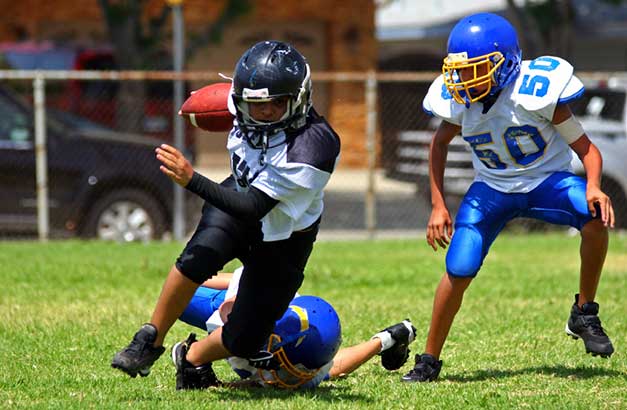
What can you do when your son (or daughter) announces he’s made the football team and all you’ve been hearing is risk, risk, risky business? First, know and understand the risks.
The evidence is growing and growing more serious about the longterm effects of football and head injuries. Players who’ve taken a hit to the head are now seen as potential victims of undiagnosed brain injuries. But it would take a major revolution to separate kids from football. It’s one of the most popular youth sports, with more than 1 million players in high school alone. Banning tackling would dramatically reduce the risk but football afficionadoes argue that it would also change the nature of the sport.
As a parent, what should you do when your son (or daughter) announces that he’s made the team? Well, you can acquaintance yourself with the risks.
Media attention and hype reached new heights this winter with the movie, Concussion, which shows patients who’ve been diagnosed with chronic traumatic encephalopathy (CTE). This is a disease characterized by abnormal protein deposits in the brain, suspected of causing severe early dementia.
Football, boxing, mixed martial arts, ice hockey and other sports that involve repeated blows to the head may lead to CTE and eventually major depression, loss of memory, suicidal tendencies, or drug and alcohol abuse. Recently, an opinion piece in the New York Times written by Bennet Omalu, chief medical examiner of San Joaquin County, California and associate clinical professor of pathology at the University of California, Davis, suggested banning youth football. The essay was accompanied by a photo of skinny kids, with helmets like outsized kettles balancing on their scrawny necks.
Maybe we don’t need to throw out the baby with the bath water. The American Academy of Pediatrics (AAP) proposes a number of changes that would help prevent brain injuries, such as no-contact practices, better equipment, and strengthening exercises, among others. The AAP also warns that coaches and officials should stringently enforce the rules of tackling, with zero tolerance for head-first hits. Non-tackling leagues could be encouraged so young athletes have a choice between no-touch football and the tackling type.
Many pro-football experts note that obesity, not brain injuries, is a greater threat to the health of young Americans and that outlawing youth football would have a negative effects on our efforts to get kids moving more.
Something’s Got to Give in Head Injuries
In the big scheme of things, football is not the leading cause of brain injury in young people— gun violence, car crashes, and drug/alcohol abuse all send more victims to the hospital. But football is a game young people choose to play, a game that society encourages for its wholesome aspects. So it seems the only rational course is to improve the game and create more outlets for safer football.
Here are some steps that could be taken:

- Put more emphasis on teaching the proper technique for tackling.
- Have experienced athletic trainers on the sidelines to supervise and advise players and coaches. (This has shown to reduce injury rates.)
- Explain to players that non-contact football is a legitimate and respected sport in its own right.
- Make sure that clothing & protective equipment are age-appropriate and well-fitted.
Jury Is Still Out . . . on Football for Kids
No decision will be forthcoming on the national scene for some years, if ever. Parents & players must come to their own conclusions on the benefits and risks of the game.
As sports medicine specialists, we naturally favor an active lifestyle. We know too well that many of our children suffer from lifelong physical disabilities that stem from inactivity. Diabetes, high blood pressure, obesity, heart problems and many other illnesses could be cured or seriously moderated if children had an activity that they loved and embraced eagerly. It’s up to parents to make sure that the activity they choose doesn’t cause longterm injury.











